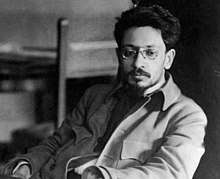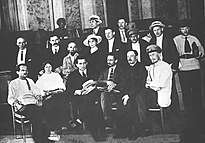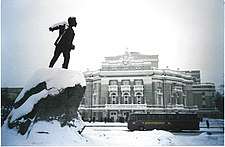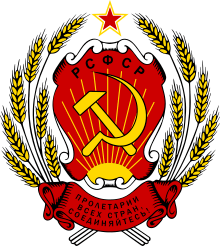Yakov Sverdlov
| Yakov Sverdlov Я́ков Свердло́в | |
|---|---|
 | |
| Chairman of the Secretariat of the Russian Communist Party (Bolsheviks) | |
|
In office 1918 – 16 March 1919 | |
| Preceded by |
Elena Stasova (as Technical Secretary) |
| Succeeded by | Elena Stasova |
| Chairman of the Central Executive Committee of the All-Russian Congress of Soviets | |
|
In office 21 November 1917 – 16 March 1919 | |
| Preceded by | Lev Kamenev |
| Succeeded by | Mikhail Vladimirsky |
| Member of the 6th, 7th Bureau | |
|
In office 29 November 1917 – 16 March 1919 | |
| Member of the 6th, 7th Secretariat | |
|
In office 6 August 1917 – 16 March 1919 | |
| Personal details | |
| Born |
3 June 1885 Nizhny Novgorod, Nizhny Novgorod Governorate, Russian Empire |
| Died |
16 March 1919 (aged 33) Moscow, Russian SFSR |
| Citizenship | Soviet |
| Nationality | Russian |
| Political party | Russian Communist Party (Bolshevik) |
| Spouse(s) | Klavdia Novgorodtseva |
Yakov Mikhailovich Sverdlov (Russian: Яков Михайлович Свердлов; 3 June 1885 – 16 March 1919) known by pseudonyms "Andrei", "Mikhalych", "Max", "Smirnov", "Permyakov"; was a Bolshevik party administrator and chairman of the All-Russian Central Executive Committee.
Early life

Sverdlov was born in Nizhny Novgorod as Yakov Mikhailovich Sverdlov to Jewish parents Mikhail Izrailevich Sverdlov and Elizaveta Solomonova. His father was a politically active engraver who produced forged documents and stored arms for the revolutionary underground. The Sverdlov family had six children: two daughters (Sophia and Sara) and four sons (Zinovy, Yakov, Veniamin, and Lev). After his wife's death in 1900, Mikhail converted with his family to the Russian Orthodox Church, married Maria Aleksandrovna Kormiltseva, and had two more sons, Herman and Alexander. Yakov's eldest brother Zinovy was adopted by Maxim Gorky, who was a frequent guest at the house.
Yakov Sverdlov joined the Russian Social Democratic Labour Party in 1902, and then the Bolshevik faction, supporting Vladimir Lenin. He was involved in the 1905 revolution while living in the Ural Mountains.
After four years of high school, he became a major activist and speaker in Nizhny Novgorod. For most of the time from his arrest in June 1906 until 1917 he was either imprisoned or exiled. During the period 1914–1916 he was in internal exile in Turukhansk, Siberia, along with Joseph Stalin. Both had been betrayed by the Okhrana agent Roman Malinovsky. Like Stalin, he was co-opted in absentia to the 1912 Prague Conference.[1]
Party leader

After the 1917 February Revolution Sverdlov returned to Petrograd from exile and was re-elected to the Central Committee of the Communist Party. He played an important role in planning the October Revolution. He first met Lenin in April 1917 and was subsequently trusted as the chairman of the Central Committee Secretariat.[2] Sverdlov was elected chairman of the All-Russian Central Executive Committee in November, becoming thereby de jure head of state of the Russian SFSR until his death. He played important roles in the decision in January 1918 to end the Russian Constituent Assembly and the subsequent signing on 3 March of the Treaty of Brest-Litovsk.
Sverdlov had a prodigious memory and was able to retain the names and details of fellow revolutionaries while in exile. His organizational capability was well-regarded and during his chairmanship thousands of local party committees were initiated. [2] Sverdlov is sometimes regarded as the first head of state of the Soviet Union, although the Soviet Union was not established until 1922, three years after his death.
Romanov family
A number of sources claim that Sverdlov played a major role in the execution of Tsar Nicholas II and his family on 17 July 1918.

A book written in 1990 by the Moscow playwright Edvard Radzinsky claims that Sverdlov ordered their execution on 16 July 1918. This book as well as other Radzinsky's books were characterized as "folk history" (Russian term for pseudohistory) by journalists and academic historians.[3][4][5][6][7] However Yuri Slezkine in his book The Jewish Century expressed a slightly different opinion: "Early in the Civil War, in June 1918, Lenin ordered the killing of Nicholas II and his family. Among the men entrusted with carrying out the orders were Sverdlov, Filipp Goloshchyokin and Yakov Yurovsky".[8]
The 1922 book by a White Army general, Mikhail Diterikhs, The Murder of the Tsar's Family and members of the House of Romanov in the Urals, sought to portray the murder of the royal family as a Jewish plot against Russia. It referred to Sverdlov by his Jewish nickname "Yankel" and to Goloshchekin as "Isaac". This book in turn was based on an account by one Nikolai Sokolov, special investigator for the Omsk regional court, whom Diterikhs assigned with the task of investigating the disappearance of the Romanovs while serving as regional governor under the White regime during the Russian Civil War.[9]
According to Leon Trotsky's diaries, after returning from the front (of the Russian Civil War) he had the following dialogue with Sverdlov:[10]
My next visit to Moscow took place after the [temporary] fall of Ekaterinburg [to anti-Communist forces]. Speaking with Sverdlov, I asked in passing: "Oh yes, and where is the Tsar?"
"Finished," he replied. "He has been shot."
"And where is the family?"
"The family along with him."
"All of them?," I asked, apparently with a trace of surprise.
"All of them," replied Sverdlov. "What about it?" He was waiting to see my reaction. I made no reply.
"And who made the decision?," I asked.
"We decided it here. Ilyich believed that we shouldn't leave the Whites a live banner to rally around, especially under the present difficult circumstances."
I asked no further questions and considered the matter closed.
The investigating magistrate in Ekaterinburg in 1918 saw the signed telegraphic instructions to murder the Imperial Family came from Sverdlov. These details were published in 1966.[11] In 1924, Yekaterinburg was renamed Sverdlovsk in his honour.
Death

Sverdlov is commonly believed to have died of either typhus or most likely influenza, during the 1918 flu pandemic, after a political visit to Oryol.[12][13] He is buried in the Kremlin Wall Necropolis, in Moscow.
His son Andrei had a long career as an officer for the Soviet security organs (NKVD, OGPU). His niece Ida married NKVD chief Genrikh Yagoda.
Legacy
- The Imperial Russian Navy destroyer leader Novik (commissioned during 1913) was renamed Yakov Sverdlov during 1923.
- The first ship of the Sverdlov class cruisers was also named after him.
- The city of Yekaterinburg had the name of Sverdlovsk in the USSR (1924–1991).
- A few locations in the former Soviet Union still bear Sverdlov's name, in the Russian Federation and in Kyrgyzstan. Others have been renamed. In Ukraine the Ukrainian government on 12 May 2016 renamed Sverdlovsk to Dovzhansk although they could not enforce this decision due to the War in Donbass.[14]
See also
- Zinovy Peshkov (Zinovy Sverdlov), Yakov's brother
- Stewart A. Swerdlow, Yakov's great-nephew, a conspiracy theorist
References
- ↑ Kotkin 2014, p. 154.
- 1 2 Kotkin 2014, pp. 193–194.
- ↑ A. Balod (23 November 2005). "Восемь ножей в спину науке, которая называется "история" // 8 knives into the back of science called history" (in Russian). ru:Сетевая Словесность. Retrieved 27 March 2009.
- ↑ Н. Ажгихина // N. Azhgikhina Терминатор мировой истории // Terminator of the world history Archived 17 February 2012 at WebCite // НГ-Наука (Nezavisimaya Gazeta), 19 January 2000. (in Russian)
- ↑ Заболотный Е. Б., Камынин В.Д. // E. B. Zabolotny, V. D. Kamynin. К вопросу о функциях и месте историографических исследований в развитии исторической науки // On the question of function and place of historiographical studies in development of historical science // Вестник Тюменского государственного университета // Messenger of the Tyumen State University. 2004. № 1. С. 84 (in Russian)
- ↑ I. Kolodyazhny // И. Колодяжный Разоблачение фолк-хистори // Disclosure of the folk history Archived 15 April 2012 at the Wayback Machine.. – ru:Литературная Россия // Literary Russia, № 11. – 17 March 2006.
- ↑ V. Myasnikov (2002). "Историческая беллетристика: спрос и предложение // Historical belles-lettres: demand and offer". // Novy Mir (New World).
- ↑ Slezkine 2011, p. 178.
- ↑ Slater, Wendy (2007). The Many Deaths of Tsar Nicholas II; Relics, remains and the Romanovs. Abingdon, Oxon, England: Routledge. pp. 71–73. ISBN 0-203-53698-3.
- ↑ Лев Троцкий, "Дневники и письма", Эрмитаж, 1986, pp. 100-101
- ↑ Alexandrov, Victor, The End of the Romanovs, Hutchinson, London, 1966, p.226-230.
- ↑ Kotkin 2014, pp. 318–319.
- ↑ Khrushchev 2006.
- ↑ "Rada renames some population areas in occupied Donbas as part of decommunization campaign". Interfax-Ukraine. 12 May 2016. Retrieved 20 July 2016.
Sources
- Kotkin, Stephen (2014). Stalin: Volume I: Paradoxes of Power, 1878-1928. Penguin. ISBN 978-1594203794.
- Khrushchev, Nikita Sergeevich (2006). Memoirs of Nikita Khrushchev. Penn State Press. ISBN 0-271-02861-0.
- Slezkine, Yuri (2011). The Jewish Century. Princeton University Press. ISBN 978-0691127606.
External links
| Wikimedia Commons has media related to Yakov Sverdlov. |
| Political offices | ||
|---|---|---|
| Preceded by Lev Kamenev |
Chairman of the Central Executive Committee of the All-Russian Congress of Soviets 1917–1919 |
Succeeded by Mikhail Vladimirsky |
